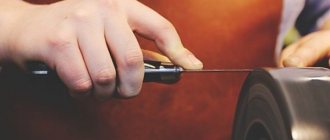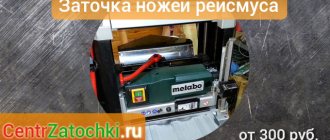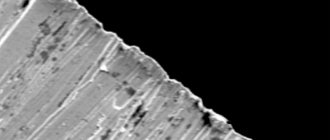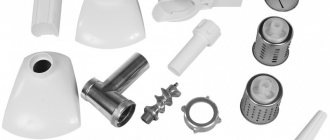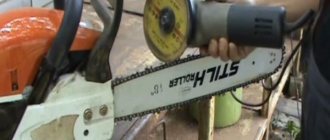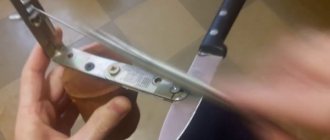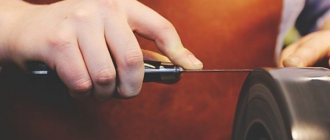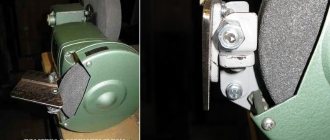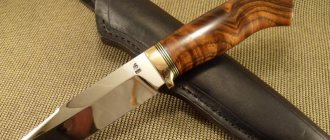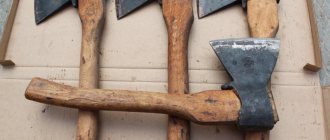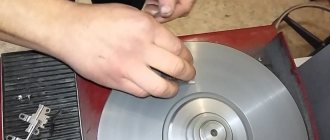What types of knives are there?
When reading about sharpening a blade, many assume a bladed weapon intended for combat. In fact, most often you have to cut bread or sausage, spread butter or paste. The table set includes several knives for:
Types of table knives are for:
- Fried chicken cutters are blades with a thick blade at the base and a somewhat obtuse angle at the top of the tip.
- Cutting pieces of fried or stewed meat requires thin, light strips of metal with razor sharpness.
- Eating fried or boiled fish - here the front part has small teeth, suitable for extracting small bones.
- Spreading plastic products (butter, paste, caviar and others) – they don’t even think about the spiciness; it’s more important to have a solid flat surface to make it more convenient to distribute the material.
- Cutting cheese with a wavy blade shape - this is the surface that prevents sticking. The movement is carried out from top to bottom, it is not accompanied by longitudinal movement, which is usual for other products.
- Cutting fruit from compote - very short, rounded blades. Some specialists cut small teeth closer to the handle to saw through the fibers.
- There are several options for peeling apples and removing the core, and there are also exotic designs.
- Cutting meat into pieces, removing veins and films when cutting fillets.
Some craftsmen classify knives as cleavers and small axes, without which it is difficult to imagine kitchen utensils. Even a tool for preparing chops, equipped with a set of needles, is classified as a special type of blade.
Vegetable shredder, fixed blade:
Design Features
Different nations have their own preferences in the types of cutting tools used.
- In Central Asia, pchaks are used - these are products made of mild steel. During use, they are often sharpened using any hard object, for example, the back of a bowl.
- The peoples of the North and Siberia use their own type of knife - the Yakuts. The short but wide blade is convenient for cutting the carcass of a large animal or fish. They are used for skinning during slaughter. If necessary, sharpen the wood using the same blade. It's universal. Children learn to use sharp tools from an early age.
- North American Indians use their own type of knife. Many consider the shape to be close to ideal. Low carbon steels are used for manufacturing and require regular sharpening.
- There is a lot of talk about Japanese cutting tools. But this is more than a legend. They were invented relatively recently. Famous samurai katanas are mounted and stored on special stands. In reality they are used much less often than they are said to be. Rare specimens have the sharpness that is shown in feature films. Military weapons, even in training combat, become dull and get defects on the edges.
- Scandinavian knives are known under the general name Finnish, implying Finnish origin. In their homeland, they are used in everyday life, for cooking and working with wood. But in Russia, these blades are more often mentioned in a criminal context.
Typical Finnish knife:
- With fairy tales from Persia came stories of Damascus steel. She is credited with unusual properties. The illustrations depict curved, pointed blades. In fact, artists exaggerate reality. The reality is much closer to the traditional execution.
- The boot knife became widespread among the Slavic tribes. It got its name from the way it was worn - in the top of a boot. There were male and female versions. They differed in size. The main purpose is to perform household work around the house and in the forest. They were made from alloys by forging.
Read also: Fiolent milling cutter MFZ 1100
- Throwing knives are currently used in sport throwing. There are several dozen options. They use elastic materials that can withstand impacts that may occur on different surfaces.
There is no single European knife. Different localities used their own variants. Often they were borrowed from neighbors who came on aggressive campaigns.
Separate from knives, a whole class of bladed weapons is presented. This:
- Swords of different types (with straight and curved blades).
- Broadswords, swords and rapiers, as well as short varieties (daggers and stilettos).
- Sabers and checkers are weapons of foot and horse formation.
- Halberds, poles, axes - bladed weapons mounted on a wooden handle.
What to sharpen
Musat
tojiro.spb.ru This tool is very similar to a file: a long round rod with a notch and a handle.
It is mainly used for straightening the cutting edge of a knife. This is useful because it allows you to keep the knife in working condition at all times. But if the blade has become very dull, grinding stone will not help you - a major sharpening is necessary. The Lifehacker Telegram channel contains only the best texts about technology, relationships, sports, cinema and much more. Subscribe!
Our Pinterest contains only the best texts about relationships, sports, cinema, health and much more. Subscribe!
Buy
Mechanical sharpener
cook-r.ru
Not a bad thing that every housewife should buy. Well suited for sharpening kitchen knives as it is quick and easy. True, the quality is not always pleasing, and the knives become dull as quickly as they are sharpened. This method is suitable for a kitchen knife, but no more.
Buy
Electric sharpener
klevin-knife.ru
An excellent way to quickly and efficiently sharpen knives with any type of blade, as well as scissors and even screwdrivers. The device is capable of sharpening and then polishing any blade in two minutes. It is important that it automatically determines the desired sharpening angle, but we will talk about this below. Such a thing will cost from 2 to 50 thousand rubles, depending on the sharpening speed, guide system and power.
Buy
Abrasive wheel machine
kak-eto-sdelano.livejournal.com
This is a professional tool; it is used to sharpen and polish blades at industrial enterprises. Without experience, it is better not to go to the machine: steel is hardened at a certain temperature, so uncontrolled heating on the machine during sharpening can irreparably damage the knife. Leave this method to the professionals.
Grindstone
tojiro.spb.ru
Sharpening with a whetstone is one of the most effective methods. This process is not easy, but entertaining. It requires perseverance and some experience working with a bar. For sharpening, two stones are needed: with small grains and large ones.
There are two types of whetstones: natural and artificial. The whole difference is in the grain size: natural stones are usually fine-grained, they are used for polishing. And artificial ones are initially made more universal, with different degrees of grain on different sides of the bar.
Buy
Purpose of products
The following types of knives are distinguished:
- Household knives for crafts, they are used for cutting wood products and other craft materials.
- Kitchen products for cooking. These products are subject to more stringent requirements; the steel must not rust and remain in a sharp state for as long as possible.
- Pencil pens were used by clerks to sharpen goose feathers. They were made foldable. Therefore, the term has taken root for all types of folding products.
- Cutlery sets are used as part of cutlery sets.
- Hunting - intended for use in cutting carcasses and removing skins. A necessary function may also be to inflict fatal blows on the animal (hunting situations can get out of control).
- Combat - here different manufacturers offer their range of blades. Demand creates supply. In every country there are dozens of firms that are looking for contracts for the supply of weapons. Therefore, these products are presented most fully on Internet resources.
- Survival knives - this name was invented relatively recently. There are many options, but the survivalists themselves can be reread on one hand. Here are blades for universal use, more like hunting accessories.
Selection of sharpeners by type of blade material
There are some subtleties to consider when choosing the best knife sharpener based on the type of blade material. So:
- soft metal products must be sharpened with medium-grained material and then ground with fine-grained material;
- if the alloy from which the knife is made is hard, then a diamond-coated material is needed, for example, ceramics or carbide;
- Ceramic knives need to be sharpened using mechanisms with a diamond-coated surface.
Otherwise, the criteria depend only on personal preferences.
Materials for making blades
A variety of steels and alloys are used for manufacturing. The following classification is accepted:
- Mild structural steel is used for folk types of products. Usually produced by forging from porous iron, obtained by direct smelting from ore, bypassing the production of cast iron. Technologies came from China and Central Asia. Found in North and South America.
- Carbon steel is used to produce cutting tools with high hardness (HRC 55...64). Such materials began to be used from the middle of the 17th century. Analysis of earlier products shows that the quality of the material is low. To give greater strength, the blades were made wide and thick, making it easier only by turning the fullers along the length.
- Stainless steel most often does not have high strength. It is viscous and plastic. The main advantage is that it is not subject to corrosion. Used to make blades in cutlery.
- Alloy steel (the so-called carbon stainless alloys) acquires its properties due to the introduction of a number of elements (manganese, chromium, titanium, molybdenum, aluminum and other metals). It is better suited for making blades.
- Damascus steel is obtained by mechanical forging of different types of materials. Initially obtained by forging low-carbon strips of metal with graphite. As a result, cementite and spherical graphite were obtained in the blade, giving the product high hardness and wear resistance.
- Titanium powders sintered into a single body (some incorrectly call this consistency an alloy). Titanium oxide on special binder materials has wear resistance to abrasion, but is brittle. The technology for producing a thin flat blade is quite complex; several industries in the world have mastered it. Therefore, they are the only suppliers to the knife market.
- Zirconium alloys (sintered zirconium dioxide, similar in properties to titanium powders) are used to make stainless steel blades. Resistant material to acids and alkalis. The products are quite expensive, but restoring their sharpness on your own is quite problematic. It is easy to damage the cutting edge.
Read also: Power bank from a phone battery
Types of knife sharpeners
There are 3 types:
- mechanical;
- electrical;
- completely manual.
Each type differs in a number of parameters: material properties, degree of abrasiveness, functionality (adjustment of the tip angle, speed of work).
In addition, kitchen knife sharpeners vary in size. You need to determine in advance the location of such a tool in the kitchen. Manual products can be stored in a cabinet, while automatic sharpeners that are larger in size require more space.
Hand whetstones
This is the simplest option. Such sharpeners are a rectangular block made of durable material. They are characterized by varying degrees of abrasiveness, which is determined by the type of sharpening stone. They are made from natural or artificial stones.
CBN bars and Belgian slates are often used for sharpening. The last option is made from a combination of materials: slate and sandstone. Abrasive properties are provided due to the content of garnet.
Hand sharpening stones have different hardness and surface grain.
Natural stones work well on different types of steel: chromium-containing, high-alloy, carbon. They can be used for rough and fine sharpening. The result is a sharp blade. CBN bars are best used for finishing grinding. They provide softness during processing.
Hand sharpening stones come in different sizes. Most of them are small. They produce products with a handle and an anti-slip coating on one side (made of rubber). This ensures ease of use. At the same time, the speed of work increases, because the block is firmly fixed in the hand, rests on the surface and does not move. The tabletop sharpener can be put away in the closet at any time. This saves space on the kitchen countertop.
Diamond sharpeners
An example of a diamond sharpener in a compact folding case.
Products of this type last longer, due to their design. Diamond chips are applied to the metal bar. This ensures a sufficient degree of abrasiveness and, as a result, wear resistance of the products.
This type of sharpener can even be used to work with cutting tools made of hard alloys.
Sharpening takes a long time, while ensuring high quality sharpening of the blade. Externally, a diamond stone differs little from a standard product.
Water stones
Unlike other types of sharpeners, which are used to work on a dry surface, water stones provide better results after treating the material with water. Oil is not used for this.
When sharpening is performed, a substance with abrasive properties is formed. Thanks to it, roughing and finishing processing is performed. To obtain a blade that matches the sharpness of a razor, alternate cutting edges with varying degrees of abrasiveness.
Mechanical sharpeners
You can use a more complex tool than hand blocks. With their help, the desired degree of blade sharpness is achieved faster. Design features: emphasis for stability, different shapes and sizes of abrasive stone.
A common model includes 2 parallel wheels with a pre-set blade sharpening angle - ranging from 25 to 30°. The mechanical sharpener does not connect to a power source. The sharpening angle of the blade is determined using guides.
Inside a mechanical sharpener there are two parallel abrasive wheels pressed tightly against each other.
There are professional mechanical sharpeners. They are sold with a set of abrasive bars, changing which allows you to adjust the degree of sharpness of the blade, as well as with blade locks and other auxiliary elements. Mechanical sharpeners can remove imperfections and polish surfaces.
Knife with vacuum fastening
The device is distinguished by the presence of suction cups in the lower part of the body. Thanks to this fastening method, stability is ensured when installing the sharpening tool. Another advantage is the blade angle adjustment. There are several sharpening zones, which allows you to sharpen knives and scissors, blades of various sizes.
Brass knuckles
The brass knuckle-shaped sharpener is inconvenient to use and is only suitable as a temporary option.
This is the least suitable option due to the ill-conceived design of the device. The product, reminiscent of brass knuckles, is put on the fingers; in its upper part there are 2 sharpening zones.
The disadvantage of the device is a high degree of danger. The knife is in constant motion, and the sharpening zones are of small length and depth. As a result, the blade may slip and cut your hand. The tool is sharpened in 2 stages.
In addition, the processing quality is not high enough. The blade edge may become uneven with frequent use. This is due to uneven sharpening. However, this option is suitable for home use: the sharpener is small in size and can be easily stored in a drawer.
Sharpening system
Such devices are used in everyday life and for professional purposes. The design is a stable machine, equipped with a knife lock, an abrasive bar mounted on a rotating rod, which makes it possible to sharpen the blade at the desired angle. The sharpening system is also suitable for scissors.
This is the most effective type of mechanical tool. Its advantage is its ability to maintain the same sharpening angle. However, it is necessary to provide storage space, since the device is large.
Electric cutters
The electric knife is convenient and practical to use.
This group includes functional devices that are simple in design, but at the same time provide high quality sharpening. They are used to work with knives made of different materials, including ceramics.
The structure of the electric knife is quite simple: it has a plastic body, inside there are diamond discs, partially covered on top with a protective material.
There are 2 to 4 grooves on the surface of the housing. A cutting tool is installed in them. Moreover, some of the grooves are intended for primary sharpening - removing rough defects, and some are used for grinding the surface. A power tool can sharpen even the dullest knife much faster. The product is connected to a 220 V power source.
Musaty
Knife sharpening musat is used only as a tool for straightening the edge of the blade.
Musat is a rod that is made from different materials: metal, ceramics, diamonds. The length of the working part reaches 25 cm. The main purpose of the musat is to correct the edge of the blade. It is not used for rough sharpening.
Using musat you can only eliminate defects on the cutting edge. For this purpose, notches are provided on the surface. They allow you to straighten the blade. For ease of use there is a handle.
How to sharpen knives?
For a blade to cut material, it must be wedge-shaped. There are several zones:
- the butt sets the thickness of the blade;
- slopes are created with the aim of gradually reducing the thickness from the butt to the cutting edge;
- The cutting edge is the main element of the blade involved in cutting materials.
When making it, the craftsman has a strip of metal. It needs to be sharpened.
Using a suitable tool, the blade is shaped to the desired shape. Here, each manufacturer has its own preferences. Usually negotiated with the customer.
Knife release shapes:
How to properly sharpen knives with a knife sharpener
To get the desired result, it is necessary to select the type of abrasive in accordance with the properties of the material from which the cutting edge is made. It is important to maintain the sharpening angle. When using a mechanical device, the process is implemented by performing reciprocating movements.
If you are not sure what blade angle is set, use an electric device. It provides all possible cutting edge positions. To properly sharpen knives, choose a model with an adjustable sharpening angle.
In addition, when using an electric device, the amplitude of the reciprocating movements is much smaller, since the sharpening zone is quite large, due to which a significant part of the blade comes into contact with the abrasive wheel.
Formation of slopes
To create oblique edges located at the desired angle, special machines are used. They are made independently or purchased from online stores.
Device for sharpening and grinding triggers:
The machine contains the following elements:
- A stand with a movable ear attached to it. It can be moved in height. As a result, the sharpening angle will change.
- The rod goes through the eye. An abrasive tool is attached to it. The most commonly used tool is a whetstone.
- A holder is a device in which a blade is secured. The design provides for a rotation of 180⁰. It's easy to flip the workpiece over so you can turn from the other side of the blade.
- The work is done by moving the whetstone from top to bottom.
View of the device from another angle:
Adjust the sharpening angle using a special protractor:
Edge sharpening
For small knives, small sharpening machines are used.
Machine for sharpening small knives:
As in the previous case, all the elements are here, only their sizes are slightly smaller. Using such a device you can sharpen cutting edges. You can determine the sharpening angle using a simple protractor. It is attached to the bar. Then the resulting value is multiplied by two.
Edge wear due to use:
If the blade is used for a certain time, then its cutting edge loses the planes that form it. Sharpening restores the original angle values.
Possible flaws when sharpening an edge:
If the optimal angle is not maintained, then the planes forming the edge will be sharpened incorrectly. Beginners are recommended to use the pre-painting method. Paint is applied to the plane, and then they are guided as the blade is sharpened. If you manage to set the sharpening angle correctly, the tool will remove paint and metal evenly over the entire surface of the plane.
Blade sharpening angles:
In practice, they use special tables where the optimal angle values can be determined for each type of blade.
Video: which knife sharpening angle is better to choose?
The evolution of devices for manual knife sharpening
High-quality sharpening has always been the main condition for working with any tool. Since the beginning of human use of metal tools, the question has always been: how to sharpen them to maximum sharpness? For this purpose, abrasive materials were experimentally identified that could quickly remove metal, various bulk and solid natural substances, and special types of stones that were most suitable for such sharpening tasks.
"Grinder".
Roman sculpture of the 3rd - 2nd centuries BC. Obviously, for many centuries the process of manual sharpening itself has not changed. The master sharpener took a specially leveled stone, pressed the sharpened tool (knife, chisel, chisel, scissors, etc.) against it on top and sharpened it using a lubricating fluid: water or oil. If the object being sharpened was large in size or had complex geometry (sword, saber, scythe, etc.), it was fixed as firmly as possible and small stones were used to sharpen the cutting edge. The main problem with this type of work was maintaining the angle. Moreover, this problem was typical for both manual sharpening and sharpening using special sharpening machines (see article). A constant angle was maintained manually both on the grindstone and on the rotating wheel. Only a sharpener of the highest class could perform such work efficiently, and naturally there were very few such specialists. However, all iron products were then made from soft carbon steel, which was used until the early 20s of the 20th century. They took sharpening quite easily and quickly became dull; the very concept of sharpness was extremely relative. However, an increase in hardness and the transition to high-quality stainless steels have significantly changed the situation. A different level of sharpening quality was required, and on an industrial scale it was achieved through the use of electric sharpening devices. However, devices for sharpening knives and tools by hand have not become a thing of the past under the pressure of electric sharpeners. They have become an attribute of home sharpening and the most precise professional sharpening, used for the hardest premium steels and expensive, artistically designed knives. At the same time, methods of maintaining the angle have changed over time.
Chinese knife sharpener 1874.
The simplest way to maintain an angle when sharpening was to create a special guide (called a “crutch” in slang). It is a metal rod with jaws on it in which the knife is fixed. By moving the jaws along the rod, the sharpening angle was set; to sharpen the other side of the supply, it is also necessary to turn over the entire structure with the knife clamped. The main disadvantage of this device is the impossibility of accurately setting the angle on this device, since it is difficult to use an electronic goniometer with this design; it will only allow you to set the angle with a fairly large error. It is also necessary to understand that the force applied by the sharpener to the guide cannot be the same throughout the entire operation. Moreover, the force must be evenly distributed along the entire length of the knife, and if the knife has a long blade, it will have to be sharpened in parts, since the length of the surface of the stone will not be enough. And in general, to work with such a device you need to have high sensitivity in your hands, and it is especially important to have it when finishing sharpening and polishing the blade. After all, with each subsequent thinner stone it is necessary to reduce the pressure and by the time of polishing it should be minimal. In addition, step sharpening or creating micro-leads remained extremely difficult. Sharpening a convex lens (convex) using such a guide was not possible.
Subsequently, the design of the guide was slightly changed and acquired additional elements in the form of special rollers. They made it possible to no longer drive the guide with your hands, but to roll it over the stone. This device became known as a carriage and was used primarily for sharpening carpentry tools: plane knives, chisels and chisels. There was also the problem of the inability to sharpen long objects. And when sharpening short metal surfaces, uneven wear of the stone occurred. And while this method of working with inexpensive abrasives was possible for tools, carriages were not suitable for knives. It was necessary to look for another solution. And over time it was found.
This solution was to create an abrasive holder on a long metal rod. When using it, it was no longer the person who moved the knife over the stone, but the stone moved from above along the surface of the knife supply. Initially, such a sharpener was held with one hand, and sharpening took place with the other. The size of the knife available for sharpening immediately increased, and it became possible to sharpen long blades. However, this format required great physical effort in the case of sharpening hard steel and long-term work. The variety of angles in such a sharpener was limited by the small number of holes into which the guide was fixed. And because of this, step-by-step sharpening and the creation of a micro-approach became impossible. Sharpening into a lens was possible in principle, but inconvenient due to the technical characteristics of the sharpener.
In order to make the work of the sharpener more convenient, a sharpening system was developed that included a platform for placing the knife and a special lift that allows you to adjust the angle setting. This solution made it possible to increase the accuracy of angle adjustment and make full use of an electronic goniometer when sharpening. Now the sharpener could work with step sharpening and easily make micro-approaches. In addition, control over the pressure on the abrasive has significantly increased. There is now an opportunity for comfortable and easy blade polishing using special polishing pastes and natural stones. But at the same time, in order to turn the knife over and cut the other side of the feed, it still had to be lifted from the platform or removed from the clamp. Thus, after the revolution, the position of the knife changed, which affected the accuracy of hitting the corner. The solution to the problem was the creation of a rotating mechanism.
TSPROF
sharpeners is a complex mechanical system that allows you to securely fix the knife, set the sharpening angle with a maximum permissible error of 0.2 degrees and maintain symmetry when sharpening both sides of the cutting edge of the knife. The rotating mechanism can be fixed with a tension wheel or a special lever, which gives the sharpener rigidity, preventing the occurrence of backlash. At the same time, the knife can be easily and quickly turned over while maintaining the angle.
And for the accuracy of setting the angle, a special lift is responsible, made both in the form of a rack and pinion lift (on the
Profile K03
), and a lift of the VC Angleset system (on the
Blitz
) or an arc post (on the
TSPROF Kadet
). Thus, the rotary mechanism, combined with a rack and pinion lift, solved many of the sharpening problems that existed in the past. The sharpening angle remains the same when turned over; sharpening into a lens is possible, as well as creating a micro-approach and step sharpening. Modern sharpeners make sharpening a pleasant and fairly comfortable experience, and turn routine work into an exciting hobby.
Table of recommendations for sharpening knives
| Knife type | Average butt thickness, mm | Blade edge sharpening angle, ⁰ |
| Sirloin | 0,8…1,4 | 5…10 |
| For cleaning fruits | 1,2…1,8 | 10…15 |
| Cutting | 1,4…2,0 | 15…20 |
| For meat and large fish | 1,8…2,8 | 20…25 |
| Vegetable hatchets, cleavers | 1,8…3,2 | 30…35 |
| Axes for chopping meat | 2,8…4,5 | 40…45 |
| Table knives | 0,8…1,4 | 55…60 |
| Hair scissors | 2,4…3,0 | 45…55 |
| Metal cutting scissors | 3,5…6,0 | 75…85 |
| Razor, scalpel | 0,7…1,1 | 10…15 |
| Hunting knife | 2,4…4,4 | 25…30 |
Using the data presented, it is not difficult to select the desired angle value for your product.
